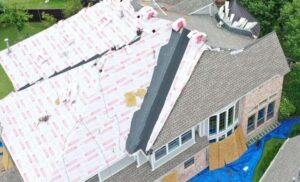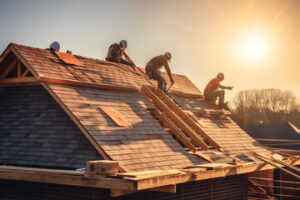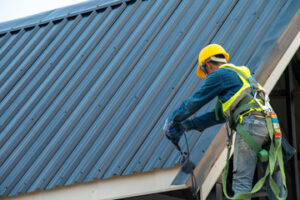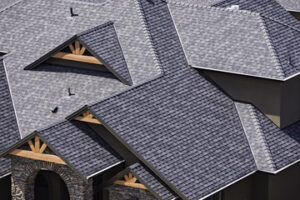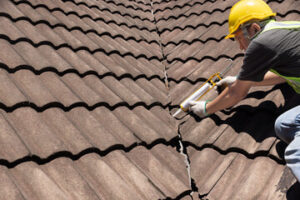Metal roofs are a durable, attractive option for any home or business. Investing in Columbus Metal Roofing helps reduce energy costs, and can also boost the resale value of your property.

Depending on the type of metal roof you choose, maintenance is typically minimal. However, cleaning and repairing dents and other damage are necessary to extend its lifespan.
Whether you’re building a new home or replacing your existing roof, longevity is an important factor when choosing a roofing material. Metal roofs can last twice as long as asphalt shingle roofs and are made from recyclable materials. They also offer energy efficiency, minimal maintenance and can be designed to mimic the look of shingles, slate or clay tile.
The longevity of a metal roof depends on the type of metal used and the climate where it is installed. Copper roofs typically have the longest lifespan, but they are expensive. Steel roofs can be corroded in coastal regions or areas with high salt content in the air, but they can still last for more than half a century if they are properly maintained.
If you are a homeowner that is concerned about the longevity of a metal roof, there are a few things you can do to help extend its life. First, make sure your roof is designed and built by a professional. Proper design and slope is essential to maximizing the longevity of your roof. Also, make sure your roof is using the proper gauge of metal. Corrugated metal roofs should never be made with 29 gauge metal and standing seam panels need to use a minimum of 24 gauge metal.
Lastly, it’s also critical to protect your metal roof from damage caused by debris. Installing gutters and drains will allow water to flow off the roof properly and prevent pooling water that can cause rust or other damage.
In addition to these measures, you can improve the longevity of your roof by applying a coating with UV protection and algae inhibitors. This will keep your roof looking its best while reducing the amount of maintenance you need to do on it.
The longevity of a metal roof is a big selling point and it’s one that many homeowners find attractive. While they may be more expensive than a traditional shingle roof, they can also provide you with a safe and secure home for the long-term. Choosing the right roofing system for your needs is all about making an educated decision based on your budget and the longevity you’re looking for.
Durability
A metal roof is much more durable than traditional asphalt shingles. It can withstand high winds, salty sea air, heavy snowfalls and hailstorms. It can also withstand fire and may even be impact-resistant. It is also less likely to crack or corrode and is extremely strong, making it a good choice for homes in areas with severe weather conditions. Many manufacturers offer a 50-year warranty on their products.
It is easy to see why so many homeowners are choosing metal roofs for their new construction or re-roofing projects. The initial cost may be higher than a shingle roof but its longevity, energy efficiency and low maintenance costs over time can make it an excellent investment.
The durability of a metal roof is another reason why it’s such a popular roofing choice for homes in hurricane-prone areas. In addition, a metal roof’s ability to reflect sunlight helps keep homes cooler in the summer months and could result in significant savings on cooling costs.
If you are thinking about installing a metal roof on your home be sure to carefully weigh the pros and cons of this type of roofing. Metal roofing does require some maintenance but is typically easier to maintain than other types of roofing materials. A regular cleaning and periodic inspection should be sufficient to keep your metal roof in excellent condition for years to come!
Unlike other roofing materials, a metal roof is not flammable which can be an important safety feature for homes in wildfire-prone areas. Additionally, most metal roofs use a reflective solar coating to minimize heat buildup which could lead to lower air conditioning costs in the summer.
When comparing bids for your roof replacement or installation, be sure that the contractor is pricing all of the same items such as labor and material. Some contractors will supply a price for labor only and then put a markup on the actual metal panels which is not an apples to apples comparison. If this is the case, be sure to ask your contractor for the name of the metal supplier they are purchasing from and the price per panel so that you can shop around for the best prices.
Aesthetics
When homeowners shop for a new roof, they look for style as well as functionality. They want a roof that will add to the home’s value and curb appeal, while offering advanced protection against extreme weather conditions.
The best metal roofing products offer a mix of aesthetic options to complement the architectural design of any building. While some may have a more industrial appearance, such as standing seam metal roofs, other styles are designed to mimic traditional shingles or natural materials like shakes and slate. Many of these models are available in different colors, giving homeowners a wide range of choices.
Many homeowners have a misconception about the appearance of metal roofs. They assume that they will be very metallic, which can be a turn-off. However, many of the products on the market today are not metallic at all. They feature matte paints and finishes, textured shingles, and other aesthetic features to make them blend with the home and enhance its visual appeal.
Standing seam metal roofs are becoming increasingly popular because of their sleek, elegant look. They are also versatile and suitable for a variety of projects. In addition, these roofs are energy efficient, allowing homeowners to save on their utility bills.
Another benefit of metal roofing is that it can be used in conjunction with a wide range of other roofing materials. This can be a good option for those who have strict HOA regulations against changing the exterior of the home. In fact, in some cases, a metal roof can even help to satisfy these rules by adding an attractive accent that will not detract from the home’s value.
Choosing a roof can be a difficult decision. There are several factors to consider, including the type of home, climate, and design preferences. Metal roofing offers a number of aesthetics to suit any preference and can be combined with almost any other roofing material. Choosing the right metal roof for your project will give you decades of durability and beauty. And with its energy efficiency and low maintenance costs, you will get the most out of your investment.
Maintenance
Despite their durability, metal roofs do require maintenance and care in order to keep them looking good and performing well. Without constant attention to their condition a metal roof can develop damage that will result in the need for repairs and replacements, or the potential for complete failure of the entire roofing system.
Regular inspection of a metal roof by a professional service can help identify problem areas before they become more serious, or even prevent the need to replace the entire roof. Ideally, this type of inspection should be performed on a biannual basis, but it may need to be done more frequently after storms or other extreme weather conditions.
A major part of maintaining a metal roof involves keeping it clean and free of debris. In some cases, this is simply a matter of using a broom or brush to remove loose dirt and dust. For stubborn dirt and stains, a gentle cleaner or mild solvent such as mineral spirits can be used to wash the area and then rinsed thoroughly with water.
It is also important to regularly clean the gutters on a metal roof in order to prevent them from becoming clogged with leaves, dirt, and twigs. Leaving this debris to accumulate can cause the gutter to overflow and possibly cause damage to the roof itself, or the home or building underneath.
Another issue that can arise with metal roofs is the deterioration of the rubber gasket that sits between the head of a screw and the roof panel. This can allow the head of the screw to come off and loosen the roof panels. This can cause rust and damage to the panel itself as it is inserted into the hole, and can lead to leaks inside the home.
Another part of maintenance that is often overlooked by homeowners is trimming any trees or shrubs that are close to the roof. If these are left to dangle over the roof they can rub against the panels during strong gusts of wind, causing dents and scratches that will detract from the beauty of a metal roof and diminish its life expectancy.

